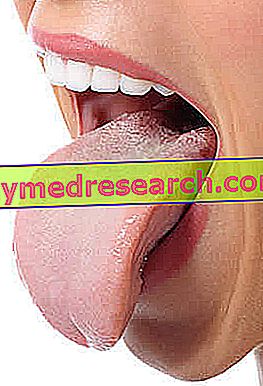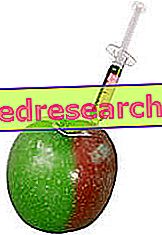Definition and causes
The white tongue represents a condition in which dead cells, debris and bacteria settle on the tongue, creating a layer that appears white and thin at sight.

Who then takes some drugs has a high probability that the dry mouth is present, another cause that gives the tongue a whitish appearance. From this statement, it can be understood why many smokers, subject to a constant dryness of the mouth, suffer more easily from this anti-aesthetic disorder.
Power and white tongue
It has been seen that an incorrect and hyper-lipidic diet can determine an alteration of the normal bacterial flora; the inevitable consequence will be the deposit of a thin layer of white mucus over the tongue. It is good to remember that "incorrect feeding" means not only too much food intake, but also excessive food restriction: this circumstance can also be a cause of the white tongue.
In the cases listed above, the white tongue represents a problem that mainly affects the aesthetic sphere: we have in fact analyzed conditions that do not favor the typical healthy appearance of the tongue - pink and shiny, soft and fluffy, with very small papillae in slight relief - connoting it only as potentially "sickly"; in these cases, the white tongue remains a condition of no concern.
We will now try to investigate the most serious causes that contribute to the formation of the white tongue: we will therefore talk about real pathologies.
Thrush
If the tongue appears white and there is an alteration of the bacterial flora, it is very likely that we are faced with a condition known as thrush, a particular mycosis that alters the normal population of bacteria present in the oral cavity. More specifically, we speak of oral candidiasis, which connotes the tongue with typical whitish spots. Fortunately, with appropriate pharmacological treatment the removal of the whitish patina and the associated infection is often easy, except in cases where the disease is an expression of a strong debilitation of the immune system.
leukoplakia
A fairly worrying condition, indicative of another type of infection, is leukoplakia, a disorder characterized by the appearance of white plaques on the surface of the tongue: it is a condition that often occurs in smokers, in which there is also an alteration of the perception of the taste of food and constant discomfort in the mouth, in addition to the typical white color of the tongue sometimes crossed by red streaks that give it a zebra-like appearance. As soon as these symptoms occur, a medical examination should be used, since leukoplakia can sometimes be a precursor to cancer. Fortunately, this does not always happen, and the disorder can be solved simply by quitting smoking.
Scarlet fever
Another pathology to be considered as a potential etiological factor is scarlet fever, a rare disease that affects infants and young children, triggered by the beta-hemolytic streptococcus in group A. The signs of scarlet fever also appear in the tongue, which undergoes transformations during the course of the pathology assuming particular connotations: in fact, initially the tongue is covered by a whitish layer with small protuberances. This typical change in the appearance of the tongue explains why we speak of a "white strawberry tongue": in fact, the fungiform papillae become hypertrophic. After a few days, however, the white tongue undergoes a transformation such as to be described with the term "red strawberry tongue": the epithelial cells are lost, a liquid stagnation (edema) of the papillae occurs, and the tongue takes on an aspect soft and velvety. After about a week, the tongue will return to normal.
Metabolic dysfunctions
The tongue may take on a whitish appearance even after a malfunction of the internal organs such as the liver and stomach.
According to some fundamentals of Chinese medicine, it seems that the white patina present on the tongue is an indication of a dysfunction of the stomach; the same aspect may sometimes depend on external humidity and cold, so much so that we speak of "cold syndrome".
Read also: White Language Remedies »



